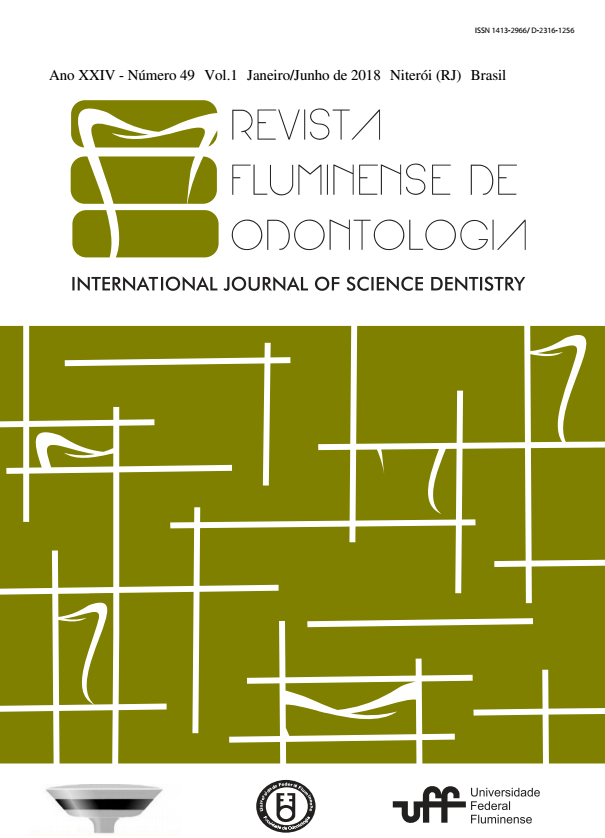Tuberculose no século XXI: Revisão de literatura com relato de caso em cavidade oral
DOI:
https://doi.org/10.22409/ijosd.v1i49.394Resumo
A Tuberculose (TB) é uma entidade de infecção bacteriana, granulomatosa, crônica e sistêmica. O agente causador, Mycobacterium Tuberculosis, pode acometer vários órgãos vitais, com maior frequência os pulmões, podendo comprometer os rins e os gânglios linfáticos, e ocasionalmente pode ser responsável por manifestações hepáticas, neurológicas e osteomioarticulares. Os sintomas clássicos da TB pulmonar incluem: tosse persistente, produtiva ou não, com muco e eventualmente sangue (hemoptise), febre vespertina, sudorese noturna e perda de peso ponderal. Na maioria dos indivíduos a infecção primária resulta apenas em um nódulo localizado, fibrocalcificado, situado no local inicial de desenvolvimento. No entanto, micro-organismos vivos podem estar presentes nestes nódulos e permanecerem latentes por muitos anos. Apenas 5 a 10% dos pacientes com TB progridem para infecção ativa e um estado de imunossupressão coexistente é frequentemente o responsável. Em raras situações, a TB ativa pode ocorrer diretamente de uma infecção primária. No entanto a doença ativa costuma desenvolver-se em fase mais tardia da vida, a partir de uma reativação do micro-organismo em uma pessoa previamente infectada. Tal reativação é caracteristicamente associada ao comprometimento do sistema de defesa do hospedeiro, sendo denominada de Tuberculose Secundária. O objetivo é realizar uma revisão da literatura sobre o tema e descrever um caso clínico de um paciente do sexo masculino, leucoderma, 35 anos de idade, com lesão em rebordo alveolar e lábio inferior com 6 cm em seu maior diâmetro, encaminhado a clínica de Estomatologia da Unigranrio / RJ, onde foi realizado o diagnóstico de TB e o paciente tratado da lesão sem as possíveis complicações desta doença.
PALAVRAS-CHAVE: Tuberculose; Micobacterium Tuberculosis; HIV; Lesões orais.
ABSTRACT
Tuberculosis (TB) is a bacterial, granulomatous, chronic and systemic infection entity. Caused by Mycobacterium tuberculosis, it most often affects the lungs, and can compromise the kidneys and lymph nodes, occasionally it may be responsible for hepatic, neurological and osteomyoarticular manifestations. The classic symptoms of pulmonary TB include: persistent cough, productive or otherwise, with mucus and eventually blood (hemoptosis), evening fever, night sweats and weight loss.
In most individuals the primary infection results only in a localized, fibrocalcified nodule located at the initial site of development. However, living microorganisms may be present in these nodules and remain dormant for many years. Only 5-10% of TB patients progress to active infection and a coexisting immunosuppressive state is often responsible. In rare situations, active TB can occur directly from a primary infection. However, the active disease usually develops later in life, from a reactivation of the microorganism in a person previously infected. Such reactivation is characteristically associated to the compromise of the host defense system, being denominated Secondary Tuberculosis. The objective is to carry out a review of the literature on the subject and to describe a clinical case of a male patient, leucoderma, 35 years old, with lesion in the alveolar ridge and lower lip with 6 cm in its largest diameter, referred to the clinic of Stomatology of Unigranrio / RJ, where the diagnosis of TB was made and the patient treated with the lesion without the possible complications of this disease.
KEY WORDS: Tuberculosis; Mycobacterium tuberculosis; HIV; Oral lesions.





